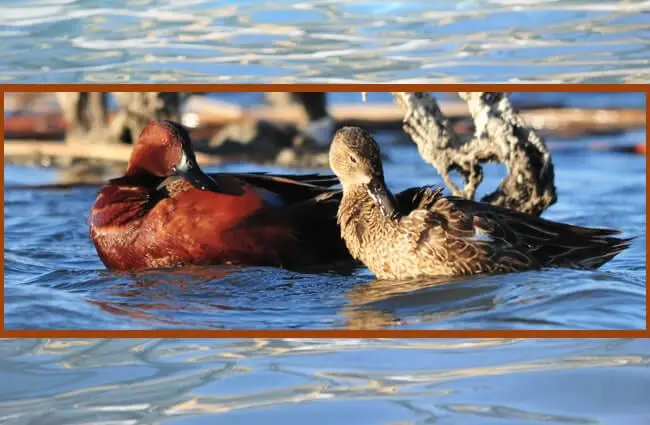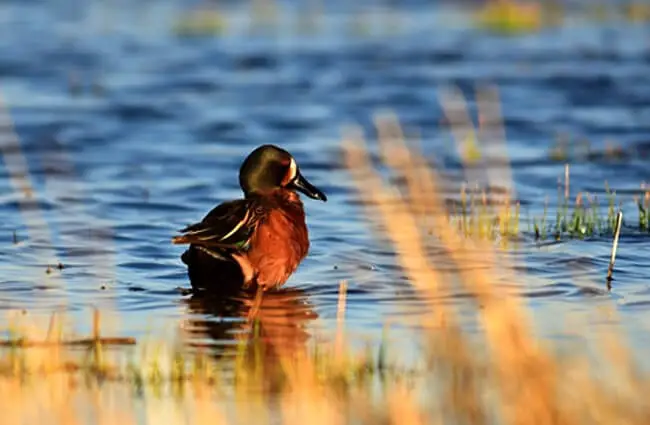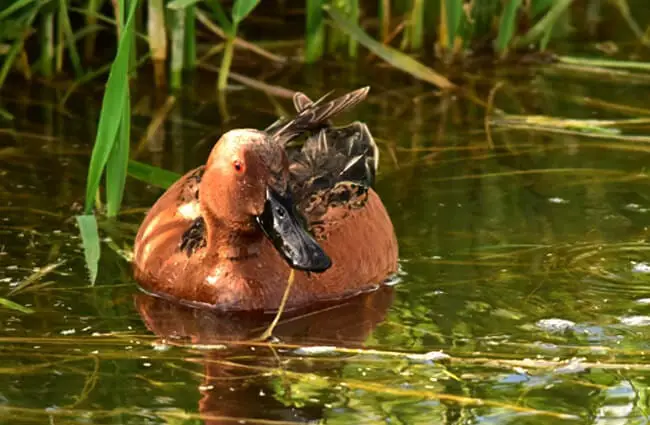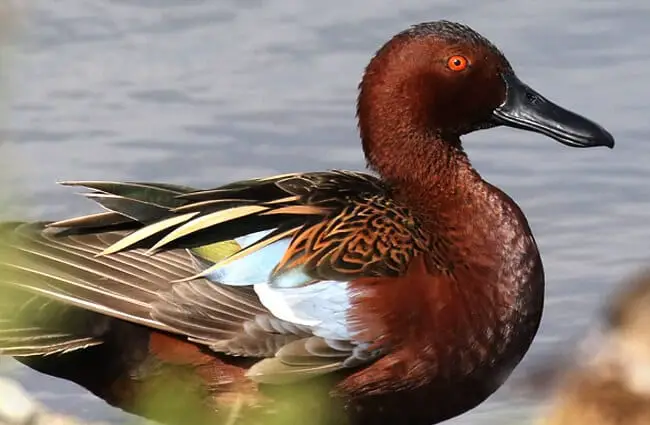The Cinnamon Teal, a captivating duck species, graces wetlands across the western United States and parts of Canada and Mexico. More than just a beautiful bird, it plays a vital ecological role and boasts a surprisingly complex life history. This guide delves into the world of the Cinnamon Teal, exploring its habits, habitat, and place within the natural world.

Identification and Physical Characteristics
The Cinnamon Teal is a small duck, easily distinguished by the striking coloration of the male. Drakes, or male Cinnamon Teals, exhibit a rich, reddish‑cinnamon hue on their heads, necks, and breast, contrasting with a dark, almost black, back and flanks. They sport a pale blue patch on their speculum, the iridescent patch on their wing, visible during flight. Hens, or female Cinnamon Teals, are more subtly colored, showcasing mottled brown plumage that provides excellent camouflage among reeds and vegetation. Both sexes have a distinctive, small, dark bill and relatively short legs. Adults typically measure between 15 to 17 inches in length with a wingspan of around 22 to 23 inches. Weight averages between 12 to 19 ounces.
Habitat and Distribution
Cinnamon Teals thrive in shallow, freshwater wetlands including marshes, ponds, and lakes with abundant emergent vegetation. They prefer areas with a good mix of open water and dense plant life, offering both foraging opportunities and protection from predators. Breeding habitats are primarily located in the western United States, particularly in states such as California, Nevada, Utah, and Colorado. During migration and winter, their range expands southward into Mexico. They are also found sporadically in coastal areas, especially during storms. A key characteristic of their habitat selection is the presence of saline or brackish water, which Cinnamon Teals tolerate better than some other duck species.

Diet and Foraging Behavior
Cinnamon Teals are omnivorous ducks with a diet that varies based on seasonal availability. During the breeding season, their diet consists primarily of invertebrates such as insects, crustaceans, and mollusks. They forage by dabbling, tipping forward in the water to reach submerged vegetation and invertebrates. Plant matter, including seeds, grasses, and aquatic plants, becomes increasingly important in their diet during fall and winter. They are opportunistic feeders and will also consume small fish and amphibians when available. Their foraging behavior is often observed in flocks, maximizing their ability to locate food sources.
Reproduction and Life Cycle
The breeding season for Cinnamon Teals typically begins in early spring, with pair formation occurring shortly after arrival on breeding grounds. They are generally monogamous, with pairs often remaining together for multiple seasons. Nests are built on the ground, typically concealed within dense vegetation near the water’s edge. The nests are constructed from grasses, reeds, and other plant material, lined with down feathers. Hens lay an average of 8 to 12 eggs, incubating them for about 23 to 25 days. Ducklings are precocial, meaning they are able to swim and forage shortly after hatching. They rely heavily on their mother for protection during the first few weeks of life. Young Cinnamon Teals reach sexual maturity within their first year, although many do not begin breeding until their second year.

Ecological Role and Interactions
Cinnamon Teals play a crucial role in wetland ecosystems. As consumers of invertebrates and seeds, they help regulate populations of these organisms. They also contribute to nutrient cycling through their waste products. Furthermore, they serve as a food source for predators such as foxes, coyotes, hawks, and eagles. They often coexist with other duck species, competing for resources but also benefiting from increased vigilance against predators. The health of Cinnamon Teal populations is often used as an indicator of wetland health, reflecting the overall condition of these important ecosystems.
Evolutionary History and Taxonomy
The Cinnamon Teal, scientifically classified as Spatula cyanoptera, belongs to the Anatidae family, which encompasses all ducks, geese, and swans. Its evolutionary lineage traces back to ancient waterfowl that originated in the Paleogene period. Within the Anatidae family, it is most closely related to other dabbling ducks in the genus Spatula. The species exhibits relatively limited genetic diversity, suggesting a possible bottleneck event in its evolutionary history. Ongoing research using genetic markers continues to refine our understanding of its evolutionary relationships and population structure.

Conservation Status and Threats
Currently, the Cinnamon Teal is listed as Least Concern by the International Union for Conservation of Nature (IUCN). However, several factors threaten its populations. Habitat loss and degradation due to wetland drainage, agricultural expansion, and urbanization are major concerns. Climate change, leading to altered precipitation patterns and increased frequency of droughts, poses a significant risk to wetland habitats. Contamination from pesticides and other pollutants can also negatively impact their health and reproductive success. Conservation efforts focus on protecting and restoring wetland habitats, implementing sustainable water management practices, and reducing pollution levels.
Cinnamon Teal and Human Interactions
Historically, Cinnamon Teals were harvested for their meat and feathers. Today, they are still hunted in some areas, subject to regulated hunting seasons. Waterfowl hunting contributes to wildlife management funds, supporting conservation efforts. Birdwatchers and nature enthusiasts often seek out Cinnamon Teals, contributing to ecotourism. Human activities can also have negative impacts, such as disturbance of nesting sites and accidental mortality from collisions with vehicles or power lines. Responsible outdoor recreation and proactive habitat management are essential for minimizing these impacts.

Encountering Cinnamon Teal in the Wild – A Guide
If you encounter a Cinnamon Teal, observe it from a respectful distance, avoiding any disturbance to its behavior. Never approach a nest or attempt to handle ducklings. If you find an injured or orphaned bird, contact a local wildlife rehabilitation center for assistance. Report any unusual observations, such as signs of disease or unusual behavior, to your state’s wildlife agency. Remember that disturbing or harming migratory birds is illegal under federal law.
Cinnamon Teal in Captivity
Caring for Cinnamon Teals in captivity requires specialized knowledge and facilities. Large, outdoor enclosures with access to clean water and ample vegetation are essential. Their diet should consist of a balanced waterfowl feed supplemented with invertebrates and plant matter. Regular veterinary care is crucial for maintaining their health. It’s vital to provide them with enrichment activities to stimulate their natural behaviors. Cinnamon Teals are social birds and should be housed with other compatible waterfowl species. Strict biosecurity measures are necessary to prevent the spread of diseases.

Fascinating Facts About Cinnamon Teal
- The name “Cinnamon Teal” refers to the male’s distinctive reddish‑brown plumage.
- They are highly adaptable ducks, capable of thriving in both freshwater and brackish water environments.
- Cinnamon Teals are known for their swift and agile flight.
- They are among the earlier duck species to arrive on breeding grounds each spring.
- Females are solely responsible for incubating eggs and caring for ducklings.
- They undertake moderate migrations, traveling several hundred miles between breeding and wintering grounds.
- They are known to form mixed‑species flocks with other waterfowl during migration and winter.
The Cinnamon Teal, with its vibrant colors and ecological importance, is a captivating species worthy of our attention and conservation efforts. By understanding its natural history and threats, we can ensure its continued presence in wetlands for generations to come.

![Red Angus Closeup of a beautiful Red Angus cowPhoto by: U.S. Department of Agriculture [pubic domain]https://creativecommons.org/licenses/by/2.0/](https://animals.net/wp-content/uploads/2020/03/Red-Angus-4-238x178.jpg)




![Red Angus Closeup of a beautiful Red Angus cowPhoto by: U.S. Department of Agriculture [pubic domain]https://creativecommons.org/licenses/by/2.0/](https://animals.net/wp-content/uploads/2020/03/Red-Angus-4-100x75.jpg)

